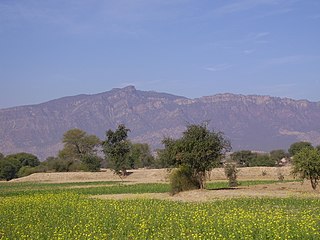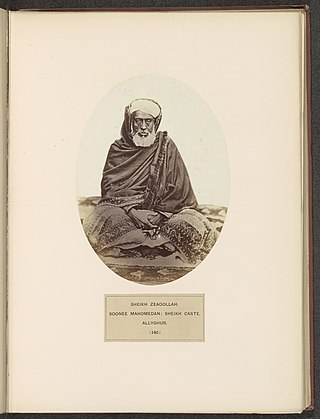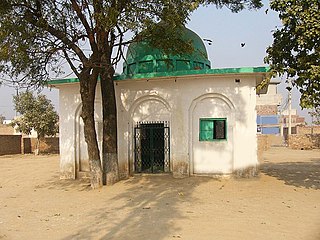
Sohawa is an administrative sub-division (Tehsil) of the Jhelum District, situated in the Punjab province of Pakistan, located in the northwestern part of the district. One sign of Sohawa is the toll plaza by the name of 'Tarakki' on the Grand Trunk Road. The main bazaar of Sohawa attracts people from nearby villages.
The Gakhar is a historical Punjabi Muslim tribe with origins in the northern Punjab, Pakistan.
Khokhar is a historical Punjabi tribe primarily native to the Pothohar Plateau of Pakistani Punjab. Khokhars are also found in the Indian states of Punjab and Haryana. Khokhars predominantly follow Islam, having converted to Islam from Hinduism after coming under the influence of Baba Farid.
Muslim Rajputs or Musalman Rajpoots are the descendants of Rajputs in the northern regions of the Indian subcontinent who generally are followers of Islam. They converted from Hinduism to Islam from the medieval period onwards, creating various dynasties and states while retaining Hindu surnames such as Chauhan. Today, Muslim Rajputs can be found mostly in present-day Northern India and Pakistan. They are further divided into different clans.

Chamar is a community classified as a Scheduled Caste under modern India's system of affirmative action that originated from the group of trade persons who were involved in leather tanning and shoemaking. They are found throughout the Indian subcontinent, mainly in the northern states of India and in Pakistan and Nepal.

Haji Muhammad Naushāh Ganj Bakhsh was a Punjabi Muslim Sufi saint and scholar from Gujrat in Pakistani Punjab. He was the founder of the Naushahiah branch of the Qadiriyya Sufi order, and his successors came to be known as Naushāhiyyas.

Pial Kalan is a town and Union Council of Kasur District, There are 4 main residential areas of Pial Kalan, Ittehad Colony, Mohallah Arrian, Mohallah Kambohan wala, and Mian Mohallah. Ittehad Colony is the Main and Biggest Area of Pial Kalan. Pial Kalan is situated in District Kasur in the Punjab province of Pakistan. It is part of Kasur Tehsil and is located at 30°55'0N 74°13'60E with an altitude of 181 metres (597 feet).
The demographics of Rawalpindi District, a district of Punjab in Pakistan, has undergone significant changes over the years. It has been affected by turmoil in the surrounding districts.

Chiniot District, is a district in the Punjab province of Pakistan. It became the district in July 2009. Before this, it was a tehsil of Jhang District.

The Pothohar Plateau is a plateau and historical sub-region in northern parts of the Punjab region, present-day Punjab, Pakistan. Ethnic Punjabis are the native people of the area and are subdivided into many tribes and clans (Baradari).
Buddha Goraya / Budha Goraya / Budha Guraya is a town and Union Council in Nowshera Virkan Tehsil, Gujranwala District, Punjab, Pakistan. The land of buddha goraya produce many great personalities like Ch Ziaullah Goraya, Ch Attaullah goraya(Retired headmaster and a recognized farmer), and bureaucrates from their family mainly Ch Khalid Javed Goraya and Ch Khizar Zahoor Goraya and DSP CH Faisal goraya.
Sukhera or Sukheda is a tribe of Rajputs and Jats in Punjab, Pakistan. The Sukhera Rajputs originated from Abohar in what is now Punjab, India and migrated to Pakistan after the Partition in 1947.

Shaikh, also rendered as Sheikh, Sheik, Shaik, Shaykh, Shaikh, Shekh, Cheikh, Šeih, Šejh, Şeyh and other variants, is a title given to many South Asian Muslim castes. It originally was a word or honorific term in the Arabic language that commonly designated a chief of a tribe, royal family member, Muslim religious scholar, or "Elder". However in Northern India, Shaikh was used as an ethnic title, by those claiming Arab descent & Upper caste coverts to Islam like Khatris, Brahmins & Rajputs etc, particularly from prominent Muslim figures such as the Rashidun Caliphs, majority of these.

Raja is a village of Gujranwala District located in Punjab, Pakistan
Mehta Suja Railway Station is located in Mehta Suja village, Sheikhupura district of Punjab province of Pakistan.
Kakki Nau is a village 7 km southwest of Shorkot Tehsil, Jhang district, Punjab, Pakistan. It is named for a traditional tale that a dangerous lion was killed nearby.
Punjabi Muslims are Punjabis who are adherents of Islam. With a population of more than 112 million, they are the third-largest predominantly Islam-adhering Muslim ethnicity in the world, after Arabs and Bengalis.
Khandoya or Khandowa is a Punjabi Rajput sub-clan mainly present in the northern, central and western parts of the Pakistani Punjab, with significant numbers living in Jhang, Chakwal and to a lesser extent in Khandowa.
Bhatti is a Punjabi and Sindhi caste of Jats and Rajputs. They are linked to the Bhatias and Bhuttos, all of whom claim to originate from the Hindu Bhati Rajputs.









